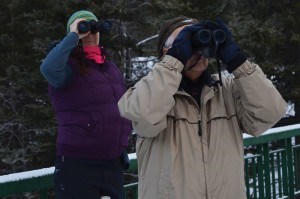
About 15 Jasperites came together Dec. 21 to participate in a 115-year-old tradition.
Just before 9 a.m., the office of the Friends of Jasper National Park bustled with activity, as participants prepared to take part in the Audubon Society’s annual Christmas Bird Count.
Touted by the society as “one of the world’s oldest and most influential citizen science programs,” the bird count aims to record worldwide trends in avian populations by taking one day a year to literally count as many birds as possible.
Each year the count happens all across North America, and in pockets throughout the rest of the globe.
Participating communities of birders pick a focal point and draw a 24-kilometre diameter circle around it, endeavoring to count as many birds as possible inside that circle.
In Jasper, that circle sits more or less at the centre of the townsite, and spreads outwards, encircling some of the park’s busiest bird habitat.
According to Gord Ruddy, who has been running the count for well over a decade, Jasper has participated since at least the 70s.
Everyone from seasoned pros and curious amateurs come out to the count. People like Ruddy and Ron Oliver, for example, are bird-watching gurus. While others, like Nadina Kaminer and Bob Ellen, are relative amateurs.
While Ellen is a bird count rookie, this is Kaminer’s second year. In 2013 she came out for the first time—to meet people and get to know some new places in Jasper—and liked it so much she returned.
“It’s great fun, everyone should do it,” she said.
As the birders disperse to their assigned locations across Jasper, Kaminer joked to Ruddy that she doesn’t really know what she’s doing.
“I’ll just be like, ‘there’s a bird,’ and that’s about all I can do,” she said.
But spotting anything did prove surprisingly difficult. Often, birds chirped merrily from the trees, while Ellen and Kaminer peered in vain through their binoculars trying to locate them.
Staking out locations throughout the town, they were able to spot a few common crows and ravens—as well as a chickadee. Nevertheless, those sightings were still marked proudly on their record page, which they would return to Ruddy at the end of the day.
But although Kaminer is fairly new to the bird-spotting game, she does know a few tricks to increase success.
Tromping through the woods just off the Highway 93A loop, she relayed a tip she got from Ruddy last year. When you hear a bird call, tilting your head to the side allows you to better locate the source, because the easiest way to pinpoint a bird is knowing how high up it is.
She explained that different birds land in different zones of a tree, so you need to look at certain heights for specific birds.
“OK, that’s it, I’m out of facts,” she joked after the brief lesson.
A little later, as she and Ellen stood on the bank of the Miette River, a small grey bird dove from the sky and plunged bravely into the icy waters.
Seeing birds is an everyday occurrence, but when it’s your sole objective for the day, every sighting becomes thrilling.
The little grey bird proved mysterious, however, as even after consulting the field book they were carrying along, the pair was unable to identify it.
“Alright, we’ve seen a bird, let’s go get coffee,” Ellen said, and they decided to take a break for some brew from the SnowDome Coffee Bar.
Kaminer and Ellen were responsible for the west end of the townsite, and would continue on in their car after the break.
The count goes from 9 a.m. to 9 p.m., and some of the more hardcore birders will stay out all day trying to count as many different species as possible. As well as in town, many will trek through the woods, hitting spots where they know to expect the biggest diversity of species.
Last year, a fairly successful one for the Jasper count, participants counted a total of 943 birds from 40 different species.
To see Jasper’s bird count results for this year, as well as data going back decades, visit www.audubon.org.
Trevor Nichols
[email protected]
